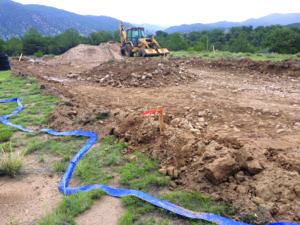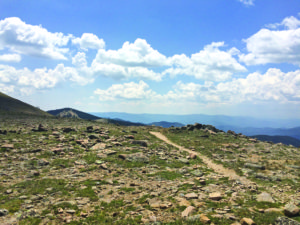By Hal Walter
At the starting line of the World Championship Pack-Burro Race in Fairplay, an ill-saddled donkey exploded bucking and kicking, causing a minor riot among the other animals and their humans waiting for the gun. On the other side of the street, another burro kicked out repeatedly in angst. My own burro tried to spin around in this chaos and head back through the crowded field, and in the process of getting her back under control she stepped on my foot, not exactly the best way to start a 29-mile race up and down a 13,000-foot mountain pass.
Meanwhile, a tourist with two little girls wandered innocently through this mayhem apparently unaware of the danger, in what must have seemed to them more like a petting zoo than a rodeo or the annual running of the bulls.
For me, looking at my 38th Fairplay race amid this pandemonium, I realized I was more fearful than I had ever been about any start, and more perplexed than ever about the sport. For one thing it was the largest field – 89 teams of runners and burros – to ever start a race. For another, I knew that many of them really had no idea what they were doing or even what would happen when the race started. Finally, I wondered when the organizers of these races and towns will make adjustments to accommodate the changes that have occurred in this sport in just a matter of a few years.
[InContentAdTwo]
For those unfamiliar with pack-burro racing, the sport is a Central Colorado original, involving a mountain adventure run alongside a donkey packed with 33 pounds. It originated as a 23-mile race from Leadville to Fairplay in 1949, and evolved to include separate races in Fairplay (29 miles), Leadville (19 miles) and Buena Vista (13 miles), as well as shorter races in other Colorado towns, including a new race in Creede.
The late Curtis Imrie, godfather and patron saint of pack-burro racing, was fond of saying in his later years, “It ain’t what it used to be, but it’ll do.” Of course, Curtis had found the sport in its true heyday, winning three world championships while competing against legendary athletes like Joe Glavenick, Ardel Boes, Lee Courkamp John Sinclair and Steve Matthews.
Curtis introduced me to pack-burro racing in 1980 at the tail end of this era. I watched Glavenick give in to age, then hand the reins to Boes who won something like an astounding nine world championships on the Fairplay course. Then as I came into my own in the sport, I competed with Tom Sobal and watched him surpass everything that Boes had done, including an astounding 11 wins at Fairplay and records that remain untouchable on every course he ran with his burro Maynard.
Back in the day, 20 teams was a big field, and while the starts were a little hairy I knew all of my fellow competitors pretty well and never felt like I was defying death. We used to joke about the sport being “discovered,” and I remember Curtis musing that some day these races would be covered by cameramen in jet-powered helicopters like the New York City Marathon.
We had no idea then that drones would be a thing. This year CNN used them to video the race at Fairplay, and in my hypoxic state on American Flats, I had the strangely violent fantasy of pulling a shotgun out of a saddle scabbard and blasting them out of the alpine sky.
When I first started racing, my goal was to finish “in the money.” Most of the races paid to 8th place and though small the field was, competitive enough that it was often difficult to go home with a check. Over time ,as my skills improved and I was fortunate enough to run with more-competitive burros, I eventually found myself often competing in the top three or four places, and even winning a few races. Over the years, I managed to win the Fairplay race seven times, and the Leadville race at least four times that I can remember.
I never thought I would see real danger in numbers with entries approaching 100 … Vendors renting burros to complete novices … “bucket listers” … saddles outfitted with GoPros … entrants traveling from other states including Wisconsin, California, Arizona and New Mexico … “burro selfies.” The irony is that I have to accept at least partial responsibility in all this with my writings and books, as well as appearances in films, videos and other media, including social platforms.
A few years ago when the film “Haulin’ Ass” was being screened at the Boulder Chautauqua, I hauled three burros for myself and friends to run in a race in Georgetown the following day. We boarded them at Boulder Valley Ranch for the night with the help of Marianne Martin, who, in addition to being the winner of the first women’s Tour de France bicycle race in 1984, is a professional photographer. While we were loading up for the race the next morning Marianne randomly took a picture of me with my burro Redbo. I liked the shot and got her permission to use it as my Facebook profile picture.
Unwittingly, I had posted the first “burro selfie,” even though the portrait was not actually a selfie. What followed over the next few years was a phenomenon of dozens of other enthusiasts pictured with burros on social media. Some events, even now, have a “burro selfie” stage. Facebook’s algorithm now parades an endless stream of burro selfies in its “People You May Know” feature, but the truth is I really don’t know most of these people at all.
I lived through that crazy start at Fairplay this summer and managed to place third. Then, the following week I ran to a fourth place at Leadville. On the third weekend at Buena Vista, cruising along in second place about two-thirds through the course, a cantankerous friendly ghost guided my burro off a tiny side trail and down a steep ravine. I had to let loose of the rope and chase her down through a sandy wash and up the other side before gathering her and returning back to the trail where I’d lost her. We gave up five places in the course of this snafu and never really recovered, finishing seventh.
Curtis always said the sport is “complete in its absurdity,” and I suppose as it becomes mainstream this is even more so. People often ask if I still race, and sometimes they also ask why. It’s because I still can. I’ve said before that burro racing has meant something different to me at different stages of my life and at 58 this still holds true. Through it all, the life lesson – regardless of how many people it attracts – remains that what matters is not what happens to you but how you deal with what happens. It’s called “resilience.”
Next summer, all powers being willing, I will attempt my 40th consecutive finish at Leadville. We believe Curtis ran the race 41 or 42 times in a row. Will I try to break his record? It would be the only one I hold after all these years at the sport. We’ll just have to see.?
Hal Walter is the author of “Endurance and Selected Essays on Autism, Neurodiversity and Deep Sport,” available at the Book Haven in Salida and online at amazon.com.



Great read, hilarious
Steve Matthews is my uncle. In 1971 I watched him win another world championship burro race (by a huge margin) in Leadville Colorado. This was one of many. His first win led to an appearance on the TV show “To Tell The Truth” in Feb. 1966. He upheld this title with his burro Charlie Brown for many years. Also he ran in the 1968 olympic narration trials and missed going to Mexico City by 13 seconds. He ran the Pikes Peak Marathon 3 times placing as high as 3rd.